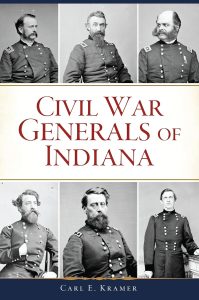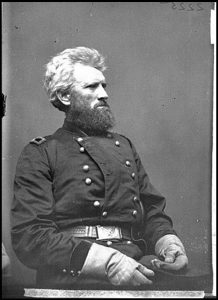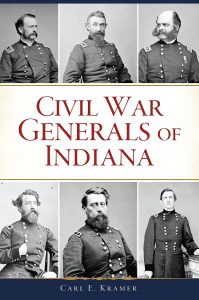Civil War Generals of Indiana Book Review

 Kramer, Carl E. Civil War Generals of Indiana. Charleston: History Press. 2022. 140 pages, 136 pages of text. Bibliography, b/w images. ISBN 9781467151955, $23.99.
Kramer, Carl E. Civil War Generals of Indiana. Charleston: History Press. 2022. 140 pages, 136 pages of text. Bibliography, b/w images. ISBN 9781467151955, $23.99.
In his acknowledgements and introduction, author Dr. Carl E. Kramer, states that this book has been an off and on-again project for more than sixty years having started it while a freshman in high school in 1961. As with any student new to Civil War studies, the term “General” can be confusing at best, thus Kramer’s long-term quest for clarity.
What Classifies a General for this Book
Let’s count down the opportunities for use of the title along with Dr. Kramer. There are those who receive appointment to the rank of general (brigadier and higher). Of course, during the Civil War that could mean in the regular army or as a general of volunteers. The President of the United States nominates a soldier to the rank of general. The Senate confirms nominations.
Second, you have Brevet Generals, those receiving a sort of temporary promotion to the rank but no real promotion. These brevets were often handed out based upon some noteworthy battle achievement most often made by a colonel or maybe even lieutenant colonel. A private or corporal would not be made a brevet general from the rank of sergeant. Brevets to lower officer positions were also possible during the war.
The third opportunity for using the rank of general is from State Troops. State Troops were most often militia groups and their appointment was made by the state governor.
Finally, you have those men who were just called general. They may have received the nickname for being a local leader, maybe it was sarcastic, or perhaps they gave themselves the moniker and it stuck for whatever reason. Needless to say, these men were not generals in the way Kramer is using the term.
How Did Kramer Decide Who is a Hoosier
Andrew Wagenhoffer points out that the issue of determining who is a Hoosier and who isn’t, is a tricky one. Then, as now, people moved around. Family members often followed each other, at times following perceived economic or educational opportunities.
In determining if a “general” was eligible for inclusion, Kramer relied heavily on the standard work in the field, Generals in Blue written by Ezra Kramer. For state level generals, he relied upon Indiana in the War of the Rebellion, a multi volume report issued in 1869 and available in a reprint edition.
Determining a tie to Indiana became more difficult for Dr. Kramer as this can mean differing things to different people. Kramer settled on three criteria for inclusion in his book. The first is birth; anyone born in Indiana who met the other criteria is included. The second qualifying criteria is for men who were born elsewhere but relocated to Indiana and spent a significant part of their lives in the state. The term “significant” is not defined and so this criterion remains vague. The final criteria that merits inclusion is for men “who arrived in Indiana early in the war, played an important role in organizing the state’s military operations and maintained a significant presence after the war.” This criterion is again vague and open to interpretation as the terms important and significant are not defined.
The Book Itself
Ultimately, Dr. Kramer has decided upon 121 men; including 44 full United States generals, 1 Confederate general (Francis Asbury Shoup), 62 Union brevet generals, and 14 state service generals. Twenty-one generals were born in Indiana as were 24 brevet generals.

Image courtesy Library of Congress
Most of the biographies are one page long. A large number of the entries contain a photo, the majority of which are from the Library of Congress. The short length of each entry makes this book appropriate to pick up and put down at your leisure. Each biography can be read in a matter of a few minutes allowing readers the flexibility to read multiple titles without worries of being bogged down. Biographies can be read in any order with no concern about being confused.
One drawback I did note is that the book does not contain end/foot notes. There is a two-page bibliography however. For me, I would have found it helpful, or at least interesting, if Dr. Kramer had listed a recommended biography (if available) for each of the entries. Brief introductions to these interesting men could leave some readers wanting more. Overall, for a book of this nature these are minor quibbles. It is also possible that the author reached his word count limit. Arcadia/History Press try to stick to specific word counts in order to keep their titles within a page limit and thus helping control price.
Readers interested in the role of Indiana in the Civil War should consider this book. Available at a budget friendly price it allows for a handy reference rather than trying to find Indiana generals at random in Warner.
Arcadia Publishing has generously provided a complimentary review copy of this book. Arcadia Publishing has also published five titles I have written as of the date of this post. My relationship with Arcadia Publishing does not influence my reviews of their titles.
If you would like to read book reviews of other Arcadia/History Press titles, please click HERE.

This post may contain affiliate links. If you click these links and make a purchase, I may receive a small commission. This commission does not affect any price that you pay. Affiliate programs or sponsors providing products do not influence the views and opinions shared on this website.
Civil War Monitor
from: Magazine Values
For some of the best in Civil War writing, I invite you to click the photo or link to subscribe to Civil War Monitor. In each issue leading scholars tackle the Civil War head on. Every issue contains book reviews helping you decide on what to read next. Beautifully laid out, this is a bi-monthly magazine you will want to keep for future reference.




